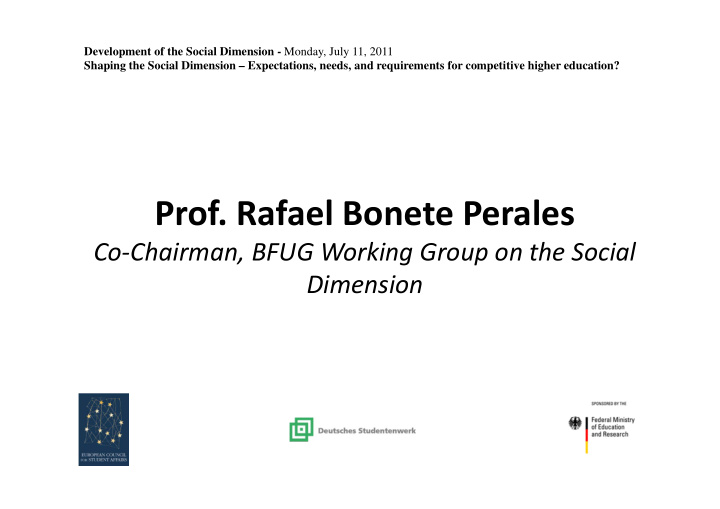



Development of the Social Dimension - Monday, July 11, 2011 Shaping the Social Dimension – Expectations, needs, and requirements for competitive higher education? Prof. Rafael Bonete Perales Co ‐ Chairman, BFUG Working Group on the Social Dimension
The Added Value of the Social Dimension Working Group Rafael Bonete Perales BOLOGNA CONFERENCE Development of the Social Dimension – Stocktaking and Future Perspectives of Student Services/Student Affairs in the European Higher Education Area . Berlin, 11 ‐ 7 ‐ 2011 19
Outline 1) Why a Social Dimension WG? 2) Specific tasks 3) SWOT analysis 4) Conclusions 20
1) Why a Social Dimension WG? In the Leuven/Louvain ‐ la ‐ Neuve Communiqué: • The Bologna Process 2020 ‐ The European Higher Education Area in the new decade , the Social Dimension has been singled out (paragraphs 9, 21, 26) as an important component of the EHEA. The Bologna Follow Up Group decided, after • some discussions, to have a WG jointly with some other WGs (www.ehea.info). 21
2) Specific tasks • To collect good practices on Social Dimension implementation in Higher Education at national and regional levels. • To collect measures taken in other sectors of the educational system within the EHEA in order to increase the level of equity in Higher Education. • To collect good practices and national experiences in defining core indicators used for measuring and monitoring the relevant aspects of the Social Dimension in Higher Education. 22
• To collect information about success stories on improving employability due to good practice in HEIs. • To explore the possibility of creating a European Observatory on the Social Dimension of Higher Education (EOSDHE). All these tasks are related with students’ affairs and services. 23
3) SWOT analysis A) Strengths - The composition of the WG : Andorra, Austria, Belgium/Flemish Community, Croatia, Czech Republic, Estonia, France, Germany, Ireland, the Netherlands, Norway, Portugal, Slovenia, Spain, the Former Yugoslav Republic of Macedonia, UK/EWNI, UK/Scotland, the European Commission, BUSINESSEUROPE, ESU, EUA, EURASHE, Eurostat, Eurostudent. - The influence on the Reporting WG and on the BFUG. 24
B) Weaknesses ‐ The effects of Fiscal consolidation on Higher Education. - The specific nature of the BFUG and the Ministerial Conferences. C) Opportunities ‐ The Social Dimension WG can try to influence the content of the next Communiqué (Bucharest, April 2012). - We can open a debate about the necessity of establishing a European Observatory on the Social Dimension of Higher Education (EOSDHE). - Learning from each other. 25
D) Threats - The Bologna Process may be losing momentum. - Market forces and Higher Education (market economy-market society-market democracy). - The different meanings of the Social Dimension and what is considered students’ affairs and services. 26
4) Conclusions Work in progress. • We need to make an effort to keep the Social Dimension high on • the agenda: – We need to convince our politicians that the Social Dimension will increase the human capital available and more talent will ensure a sustainable knowledge society. – The Social Dimension in Higher Education will also increase Social Cohesion in Europe. We still need more data to compare our different levels of support • to our students. We need to share more good practice in order to improve student • affairs and services. 27
Thanks for your attention rafael.bonete@educacion.es 28
Recommend
More recommend